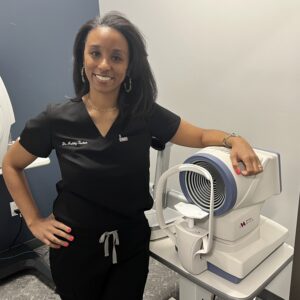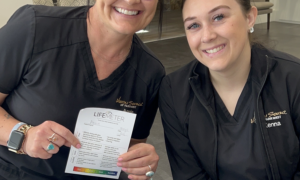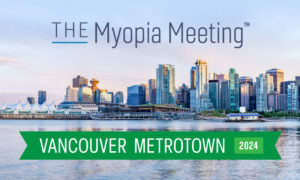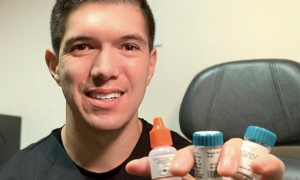
Dr. Tucker with the MYAH Optical Biometer and Corneal Topographer. She says the technology has greatly enhanced her ability to serve myopia management patients.
Topcon-Sponsored Content
By Ashley W. Tucker, OD, FAAO, FSLS, Diplomate, ABO
August 9, 2023
Providing exceptional care for your myopia management patients is paramount. Myopia not only affects quality of life but also poses risks to eye health. Gaining the trust of families to opt for vital treatment options to slow myopia and demonstrating the positive outcomes of this care are essential objectives to provide the highest level of service.
In our practice, we utilize the latest technology that empowers us to effectively monitor the state of myopia progression and demonstrate the progress of our patients’ treatments. The MYAH Optical Biometer and Corneal Topographer from Topcon Healthcare serves as the fundamental device in our practice that has significantly enhanced our ability to provide comprehensive myopia management.
Investing in the Right Technology for Comprehensive Care
As the field of myopia management has evolved, so has our practice. We have come to recognize that measuring axial length is the most accurate way to objectively assess myopia progression, and this has allowed us to establish a higher benchmark in caring for each of our pediatric patients. The ability to easily understand and convey axial length changes with the MYAH has played an instrumental role in providing effective patient education and aiding parents in recognizing the importance of myopia control.
By describing myopia as elongation of the eye rather than merely refractive error, we have successfully increased parental engagement during follow-up visits. Parents value the importance of monitoring axial growth using the MYAH, much like they would monitor their own blood pressure or blood sugar readings during a primary care appointment.
A few years ago, we encountered situations where parents organically began to ask about their child’s axial length, but we lacked the necessary technology to provide this information. We found ourselves in the position of referring these patients to external clinics for the necessary measurements. In fact, the father of one of these individuals went above and beyond, creating his own axial length progression map and plotting his child’s refractive error throughout her life. Witnessing this dedication, we recognized the immediate need to invest in a device that would allow us to track axial length changes in-house and automatically generate the full picture of progression for our patients. The MYAH is equipped with the software to precisely deliver this information and has truly become a game changer in our practice.
Providing Early Awareness with Advanced Screening
We diligently screen every child who can cooperate to identify those most at risk for myopia development. We reference axial length growth curve data based on age and ethnicity (similar to growth charts that can aid in predicting a child’s potential height). In coupling axial length data obtained from the MYAH with information regarding other risk factors such as family history, outdoor time and screen time, we are able to effectively educate parents on their child’s risk for myopia as early as possible. This empowers them to modify certain factors that can influence myopia development.
Screening every child with the MYAH has had a profound impact on our practice. By improving our understanding of which children are more prone to developing myopia, we can preemptively equip parents with the necessary information about myopia management. When the time comes, they are typically ready to embark on a myopia management program that we recommend. The availability of tools that accurately monitor myopia progression impresses parents and helps them understand the risks associated with abnormal eye growth, such as retinal detachments, primary open-angle glaucoma, cataracts and myopic maculopathy.
The concept of eye elongation has a far greater impact than a simple increase in refractive error. Refractive error was previously our only metric for measuring myopic progression, but now we have tools that help us accurately measure how much the eye is actually growing, which is a true measure of progression. Thanks to the MYAH, families can fully grasp what is at stake and witness the tremendous positive impact of the treatment their children receive in real time.
Maximizing the Full Potential of Diagnostic Devices
Looking beyond the ability to track axial length measurement, the MYAH also features a topographer, enabling us to diagnose and manage conditions such as keratoconus and other corneal abnormalities. Furthermore, this device provides pupillometry measurements, allowing us to objectively assess dynamic changes in pupil size in various light settings. This feature proves to be especially valuable when designing orthokeratology lenses and evaluating the impact of atropine on a child’s pupil size.
Other Articles to Explore
In addition to leveraging MYAH’s capabilities to elevate our practice standards, we have noticed the significance of including axial length measurements in our myopia management package. While these measurements are not billed as individual services in our practice and may not generate direct profits per se, by incorporating them into our comprehensive myopia management package, we provide families with a holistic solution that they appreciate. Parents are able to understand that our decision to acquire the MYAH was not driven solely by profit motives, but rather by our desire to invest in technology that allows us to provide the best care for our patients. In utilizing the MYAH’s full features, we are able to offer an accurate, individualized visual representation of myopia that allows us to determine the effectiveness of our management strategies.
Conclusion
In summary, incorporating the MYAH Optical Biometer and Corneal Topographer into our practice has revolutionized our ability to provide the highest level of myopia management. By measuring axial length and utilizing advanced features like topography and pupillometry, we can deliver comprehensive services while ensuring our practice is at the forefront of myopia management. The ability to screen at-risk patients early and provide families with crucial information empowers them to take proactive steps in managing myopia. Ultimately, the MYAH enables us to demonstrate the remarkable results of our treatments and the positive impact on our patients’ lives.
 Ashley W. Tucker, OD, FAAO, FSLS, Diplomate, ABO, is a partner with Contact Lens Institute of Houston (CLIH) within Bellaire Family Eye Care (BFE) in Houston, Texas. To contact her: Tucker@bfeye.com
Ashley W. Tucker, OD, FAAO, FSLS, Diplomate, ABO, is a partner with Contact Lens Institute of Houston (CLIH) within Bellaire Family Eye Care (BFE) in Houston, Texas. To contact her: Tucker@bfeye.com



























